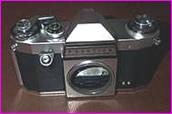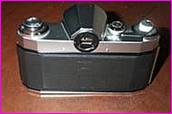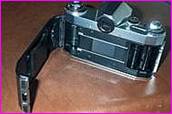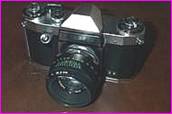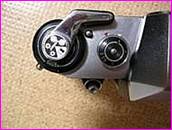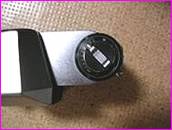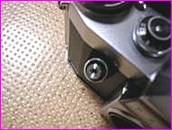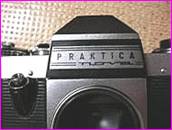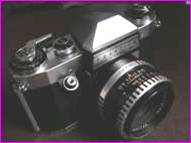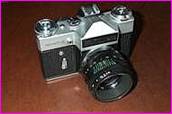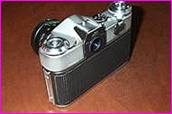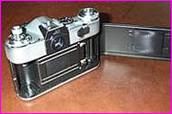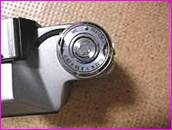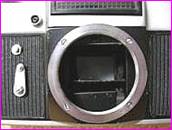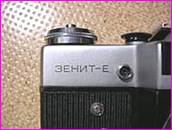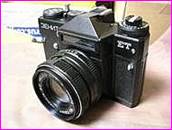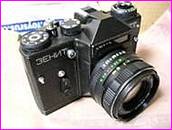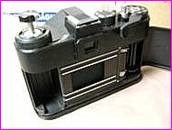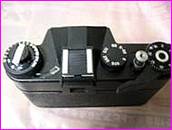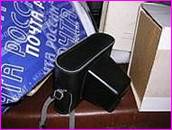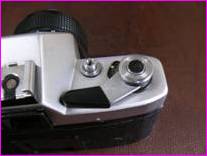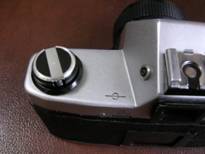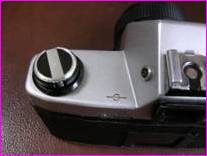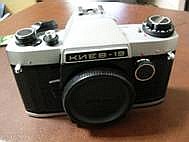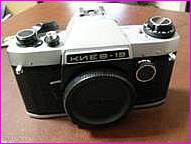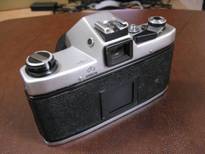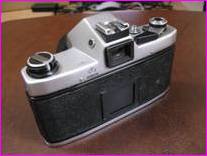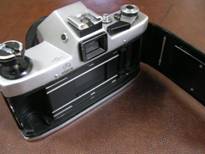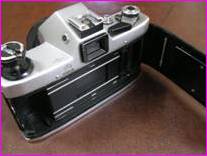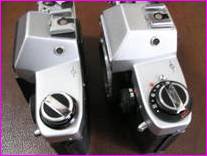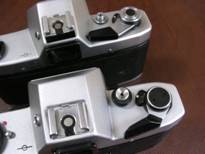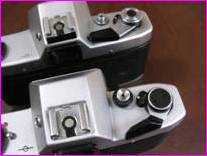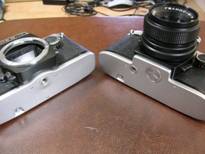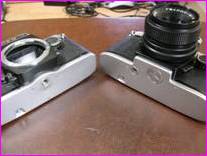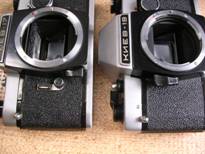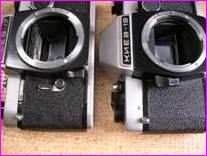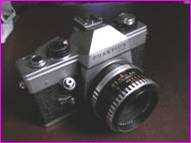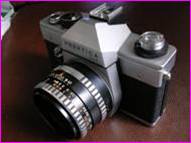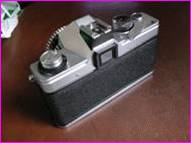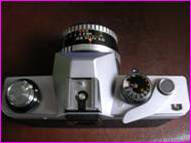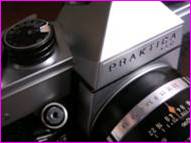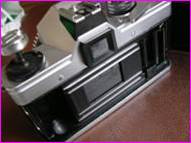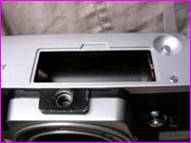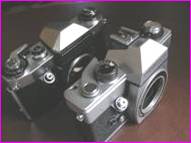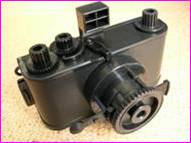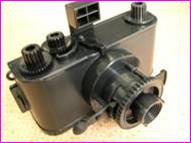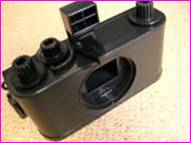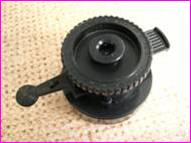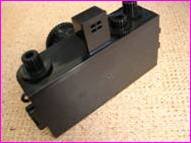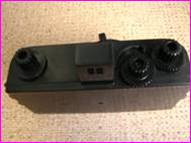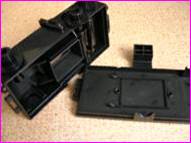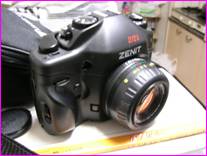|
|
|
COMMUNISTCAMERAS
(RUSSIA, FORMER EAST GERMANY, CHINA) PRAKTICA NOVA, 1st Modification |
|
MANUFACTURING COUNTRY |
Former German Democratic Republic |
|||
|
DATE OF AVAILABILITY |
1966 April |
|||
|
SUGGESTED PRICE |
unknown, bought for 5250 yen |
|||
|
TYPE |
35 mm manual focus single lens reflex |
|||
|
LENS MOUNT |
M42 |
|||
|
SHUTTER SPEEDS |
1/2 to 1/500 seconds |
|||
|
BUILT-IN FLASH |
no |
|||
|
BATTERIES |
NA |
|||
|
DIMENSIONS, WEIGHT |
154 x 96 x 48 mm (measured by owner) g |
|||
|
I first learned the brand PRAKTICA
from a magazine dedicated to used cameras. The fact that it was a former East
German camera caught my attention. Also, the fact that PRAKTICA was able to
design and manufacture electronic cameras captured my attention, since I
thought no nation mass produced electronic cameras other than Japan. I went to a camera shop that also
sold used cameras (the same shop where I bought the Zenit E a month before),
and found four Prakticas. German cameras, even
second-hand, are generally expensive, but that's former West German ones. Prakticas on display weren't that expensive, all under
10000 yen. I decided to buy them all, and saved up the cash for it. In August 2003, I headed to the
camera store, and examined the four cameras. I was immediately disappointed.
Two out of four were in extremely poor condition. That left only two. I
decided to buy the less expensive one, the Praktica
Nova. It cost me 5250 yen. It was my first former East German
camera. I've only put one roll of film into it so far, but it seems to work
reasonably well, despite the rather unclean finder. |
||||
|
PROS |
1. Solid
construction, with metal casing. 2. Exterior
finish better than Zenit E 3. Simple
to use. 4. No
batteries required. 5. The
universal M42 mount. |
|||
|
CONS |
1. Film spool
somewhat hard to use. 2. Dirty
finder. I'm sure that it's not a common problem of all Novas, but the one I
own is the only one I know. 3. Rather
large and heavy. 4. Film
counter does not budge for some reason, so there's no way of knowing how many
shots were taken. |
|||
|
Front view |
Rear view |
Rear view, with
cover open. Hinge is located on the rewind knob side. |
||
|
Front view, with HELIOS 44-2 2/58 |
Winder |
Rewind knob |
||
|
The angled shutter
button |
Detail |
|||
|
With Pentacolar 1.8/50 attached. Looks great. |
||||
|
MANUFACTURING COUNTRY |
Russia |
||
|
DATE OF AVAILABILITY |
|
||
|
SUGGESTED PRICE |
unknown, bought for 9429 yen including lens |
||
|
TYPE |
35 mm manual focus single lens reflex |
||
|
LENS MOUNT |
M42 |
||
|
SHUTTER SPEEDS |
1/30 to 1/500 seconds |
||
|
BUILT-IN FLASH |
no |
||
|
BATTERIES |
NA |
||
|
DIMENSIONS, WEIGHT |
138 x 93 x 100 mm (with lens) 920 g (with lens) |
||
|
After using the Zenit 122, I was
confident that I can use other Zenit cameras. I went to a camera shop that
also sold used cameras. Among the shelf were one Zenit 12 and two Zenit Es
(one with Roman characters, the other with Cyrillic characters). After
examining the three cameras, I decided to purchase the Zenit E with Cyrillic
letters, since I found Cyrillic characters exotic. I also decided to purchase a lens
as well, because the appearance of the only M42 mount lens I had (MC Zenitar M2s 50mm/f2, which came with the 122) didn't
match the E. The body was priced at 5980 yen (excluding tax), and the lens (HELIOS 44-2 2/58)
was priced at 3000 yen (excluding tax). The total (including tax) was 9429 yen. This was my first second-hand
camera from a non-Japanese manufacturer. |
|||
|
PROS |
1. Solid
construction, with metal casing. 2. No
batteries required. 3. The
universal M42 mount. |
||
|
CONS |
1. The user can set ISO, but I've no idea how, though I
read and reread the instruction manual. |
||
|
Front view, with HELIOS 44-2 2/58 |
Rear view |
Rear view, with
cover open |
|
|
Winder and shutter
button |
Rewind knob |
M42 Mount |
|
|
Cyrillic lettering |
|||
|
MANUFACTURING COUNTRY |
Belarus |
|||
|
DATE OF AVAILABILITY |
1984 |
|||
|
SUGGESTED PRICE |
unknown, bought for 13400 yen including lens |
|||
|
TYPE |
35 mm manual focus single lens reflex |
|||
|
LENS MOUNT |
M42 |
|||
|
SHUTTER SPEEDS |
1/30 to 1/500 seconds |
|||
|
BUILT-IN FLASH |
no |
|||
|
BATTERIES |
NA |
|||
|
DIMENSIONS, WEIGHT |
138 x 93 x 112 mm (with lens) 790 g (with lens) |
|||
|
I saw this camera in an on-line
shop, and decided to buy it immediately (although it was several days later
that I actually placed an order). It was in near-mint condition, as
advertised. It had everything, including the lens and the camera case. I was a bit surprised when I saw
the bottom of the camera. It said MADE IN BELARUS, not Russia. This camera is a modernized
version of the Zenit E series. The major change is that the casing is
plastic. Therefore, it's a lot lighter than the all-metal Zenit E. The
controls have been changed somewhat, for reason I don't know. It's not as
easy to use as the Zenit E. The greatest problem with this
camera is not the camera itself, but the leather camera case. Whoever
designed this camera case must have designed it without seeing or touching
the ET. Taking the camera out of the case is a chore. You practically have to
destroy the case every time you open the top. |
||||
|
PROS |
1. No
batteries required. 2. The
universal M42 mount. |
|||
|
CONS |
1. The user can set ISO, but I've no idea how. There
was an instruction manual, but it was in Russian. 2. Film rewind procedure is rather confusing. 3. Plastic casing. 4. Camera case seems to be designed for different
camera. |
|||
|
Front view, with
HELIOS-44M-6 |
Front view, with
HELIOS-44M-6 |
Rear view, with
cover open |
||
|
Top view |
The ill-designed
camera case and packaging |
|||
|
MANUFACTURING COUNTRY |
Russia |
|||
|
DATE OF AVAILABILITY |
|
|||
|
SUGGESTED PRICE |
13800 yen |
|||
|
TYPE |
35 mm manual focus single lens reflex |
|||
|
LENS MOUNT |
M42 |
|||
|
SHUTTER SPEEDS |
1/30 to 1/500 seconds |
|||
|
BUILT-IN FLASH |
no |
|||
|
BATTERIES |
2 x SR44 |
|||
|
DIMENSIONS, WEIGHT |
142 x 97 x 49 mm 530 g (w/o lens, 820 g with lens) |
|||
|
This was my first truly foreign camera.
I bought it brand-new from an on-line shop in July 2003. I first learned the camera brand
'Zenit' when I was surfing the net under 'Russian Cameras'. The first Zenit
camera I saw (image, of course) was the 212. Immediately interested, I
searched further, to see if there was a dealer in Japan. There was one on-line shop in
Japan that sold brand-new Zenits. I was able to
find the 212. It was then that I saw another camera: the 122, predecessor to
the 212. I mulled over for a moment, and
decided to purchase the 122 instead of the 212. The 122 was cheaper, so there
would be less damage to my wallet in case Russian cameras just weren't for
me, and being an older model, I thought that it would be out of production
before the newer 212. I placed an order at the on-line
shop, but it was over a week before I got a mail back stating that the
merchandise was sent. I had arranged to make payment at the time of receipt,
but the shop for some reason shipped the merchandise thinking that I had paid
in advance. I had to send a mail requesting them to send the bill (God, I'm
so honest!). Despite problems, I was able to get the 122 for 13800 yen. The 122 was the first manual focus
camera I have ever used (I bought a F3HP several months before, but I rarely
take it out of the box). Being used to fully automated cameras, I had some
trouble with it (I ruined two rolls of film). But once I learned its correct
operation (rather simple), I found it very usable. The 122 is practically a souped-up toy camera. It's passable to those who just
want to take pictures and don't care a thing about picture quality, or to
those who are tired of no-miss electronic AF cameras but just can't afford MF
cameras offered by major makers. Those who want a real camera with all the modern
conveniences should avoid it. |
||||
|
PROS |
1. Inexpensive. It comes with a passable lens and a
camera case, so all you need is a film. 2. Works well for its price. 3. The universal M42 mount. |
|||
|
CONS |
1. It looks inexpensive, with its plastic casing. It's
plain plastic, not engineering plastic. 2. Relatively heavy. Though it has a plastic casing,
chassis is metal. 3. Unlike the Zenit E I own, there's no Cyrillic
characters, so it doesn't feel exotic. |
|||
|
Front view, with
packaging |
Rear view, with
cover open |
|||
|
Shutter button and
shutter speed dial |
Rewind knob |
Top view |
||
|
Detail |
Detail. 'ZENIT' is
not Cyrillic |
|||
|
MANUFACTURING COUNTRY |
Ukraine |
|
|
DATE OF AVAILABILITY |
1985 |
|
|
SUGGESTED PRICE |
9450 yen |
|
|
TYPE |
35 mm manual focus single lens reflex |
|
|
LENS MOUNT |
F mount |
|
|
SHUTTER SPEEDS |
1/30 to 1/500 seconds |
|
|
BUILT-IN FLASH |
no |
|
|
BATTERIES |
|
|
|
DIMENSIONS, WEIGHT |
147 x 98 x 54 mm 690 g |
|
|
I first saw this camera on a webpage selling Russian cameras. What captured
my attention was that it had a Nikon F mount despite being a Russian camera
(well, actually, it's a Ukraine camera).
It was priced at 18000 yen. Not terribly expensive, but no pocket
change either. I began to shore up funds purchase it.
It was then that I saw the same Kiev at a second-hand camera store
during a trip. Priced at 9000 yen, it was very attractive, but it only came
with the body only. I heard countless horror stories of genuine Nikon lenses
getting stuck permanently to Kiev SLRs, so there
was no way I was going to try the Nikon mount lenses I had on Russian
cameras.
I decided not to purchase that Kiev, opting for the one sold on the
web, since it came with a standard lens.
I finally gathered the funds to purchase the Kiev a few weeks later. I
checked the webpage.
...it was not displayed any more.
Apparently, someone bought it before me.
Well, it's the story of my wonderful, beautiful, and stupendous life.
Everything's available when I don't have the cash, and nothing's available
when I do have the cash.
I visited the same camera store several months later on another trip.
The Kiev was still there, with the body only. I decided to purchase it, since
I was afraid that it will be the last time I'll ever see it.
Kiev 19 is a relatively solidly-built camera. I tested it without
putting a film into it, and it seems to be working fine.
Kiev 19 is a downgraded version of Kiev 17 (maximum shutter speed from
1/1000 sec. to 1/500 sec.). It has since been modified (many say downgraded
further) to Kiev 19M.
I later purchased the Kiev 17, which is
supposedly a higher-grade camera. Many critics blast the Kiev 19 as a
downgraded Kiev 17, because of its slower maximum shutter
speed. But comparing the two, I find Kiev 19 a better camera than Kiev 17.
That's hardly surprising, since Kiev 19 came out 8 years after Kiev 17. This proves that even communist states improve
their products. |
||
|
PROS |
1. Solid, all metal construction 2. Nikon F mount |
|
|
CONS |
1. Exposure meter no longer operable. 2. Although it has a Nikon F mount, there are rumors
that any genuine Nikon lens (especially AF lenses) will be jammed permanently,
so I'm afraid to try any Nikon lenses on it. 3. Some controls (shutter speed control, film rewind
button) at awkward positions |
|
|
Front. Lens cap is
genuine Nikon, most likely fitted at the camera shop |
Detail. 'KIEV' inscription
is in Cyrillic. |
|
|
Rear. ISO chart on
back |
With film back
open |
|
|
Later Kievs (1970 onwards) have shutter speed dial control on
front |
Film rewind button
at bottom |
|
|
With HELIOS-81C
50mm F2.0 |
With HELIOS-81C
50mm F2.0 |
|
|
Kiev
17 (left), Kiev 19 (right) |
Kiev
17 (left), Kiev 19 (right) Kiev 19 has ISO
dial |
|
|
Kiev
17 (back), Kiev 19 (front) |
Kiev
17 (left), Kiev 19 (right) |
|
|
Kiev
17 (left), Kiev 19 (right). Kiev 19 has no self-timer |
||
|
MANUFACTURING COUNTRY |
Former German Democratic Republic |
|
|
DATE OF AVAILABILITY |
1969 December |
|
|
SUGGESTED PRICE |
unknown, bought for 19440 yen, including lens |
|
|
TYPE |
35 mm manual focus single lens reflex |
|
|
LENS MOUNT |
M42 |
|
|
SHUTTER SPEEDS |
1/1 to 1/1000 seconds |
|
|
BUILT-IN FLASH |
no |
|
|
BATTERIES |
VARTA V21PX |
|
|
DIMENSIONS, WEIGHT |
154 x 96 x 48 mm (measured by owner) g |
|
|
I saw this camera on sale in December 2003, at the same camera store
where I bought the F4S.
I contemplated for a week before deciding to purchase it.
It came with the Carl Zeiss Jena Pentacolar 1.8/50 lens and a camera case.
It's a fine looking camera, with solid, metal construction.
With shutter speed up to 1/1000 seconds, it's a higher grade camera
than the NOVA. |
||
|
PROS |
1. Solid
construction, with metal casing. 2. Simple
to use. 3. The
universal M42 mount. |
|
|
CONS |
1. I seriously doubt
that the exposure meter will work, even if I was able to find the correct
batteries. 2. Shockingly dark
finder. It's nearly impossible to focus. 3. Camera case is
hard to open (are there any camera case existing that is easy to open?). |
|
|
Front view, with Pentacolar 1.8/50 |
Front view |
|
|
Rear view |
Top view |
|
|
Front detail. Note
the angled shutter button |
With rear cover
open |
|
|
Battery
compartment. Film rewind button
can be seen. |
Two Prakticas. LLC at front. |
|
|
MANUFACTURING COUNTRY |
China |
||
|
DATE OF AVAILABILITY |
2003 |
||
|
SUGGESTED PRICE |
1680 yen |
||
|
TYPE |
35 mm pinhole
camera |
||
|
LENS MOUNT |
NA |
||
|
SHUTTER SPEEDS |
1/250 seconds |
||
|
BUILT-IN FLASH |
no |
||
|
BATTERIES |
NA |
||
|
DIMENSIONS, WEIGHT |
x
x
mm g |
||
|
My first Chinese camera. It's a pinhole camera, a type of
camera that uses a tiny hole instead of a lens. The kit is equipped with a plastic
lens nonetheless. |
|||
|
PROS |
1. No batteries required. 2. Operation seems
simple. 3. Price. Costs 1680 yen brand-new,
which is the lowest I paid for a camera, and that includes second-hand ones |
||
|
CONS |
1. Everything's
plastic. 2. Made in China. 3. I put a test film in the camera,
then wound/rewound the film to check its smoothness. It wasn't very smooth.
The film was torn up in the process. |
||
|
With pinhole attached |
With lens attached |
||
|
With shutter unit detached |
Shutter unit The protruding bar on the left is the shutter button |
||
|
Rear view |
Top view |
||
|
With the back open |
Camera disassembled, and placed back in the box |
||
|
MANUFACTURING COUNTRY |
Russia |
|
|
DATE OF AVAILABILITY |
|
|
|
SUGGESTED PRICE |
16600 yen including shipping and tax |
|
|
TYPE |
35 mm manual focus single lens reflex |
|
|
LENS MOUNT |
Pentax K mount |
|
|
SHUTTER SPEEDS |
1/30 to 1/500 seconds |
|
|
BUILT-IN FLASH |
no |
|
|
BATTERIES |
|
|
|
DIMENSIONS, WEIGHT |
144 x 104 x 99 mm (with lens) 850 g (with lens) |
|
|
I placed an order for a Kiev 19M (a Russian SLR with Nikon's F-mount)
in March 2004.
A reply came back a few days later by e-mail, apologizing for the fact
that the last Kiev 19M in stock was defective, and replacement for it could
not be found anywhere in their inventory (it seemed that it is out of
production).
There was no use complaining about it, and it didn't cost me a penny
so far, so I abandoned all plans for the acquirement of the Kiev, and decided
to go for a Zenit.
I contemplated which Zenit I should buy. For some reason, I didn't
want a second-hand Zenit (probably because I was planning to acquire a new
Kiev). I decided to check the site where I bought my first Zenit.
Among many Zenits was the 212K, the very
model that taught me the existence of the Russian camera maker.
I immediately placed an order, without much thought.
The site responded immediately by e-mail, informing that shipment will
be made approximately a week later.
When I bought the 122, there was a minor
problem in shipment, but this time, everything went smoothly.
The camera came with a case, a strap, and an instruction manual (a
Russian one, and a Japanese one provided by the retailer).
The 212K is mechanically identical to 122,
other than that it has a Pentax K-mount instead of the universal M42.
Externally, 212K has a very modern form, totally different from the
orthodox-looking 122. It almost appears as if it has
auto focus, but it's a fully manual focus camera. |
||
|
PROS |
1. Inexpensive. Costs slightly more
than the 122, but only slightly more 2. Simple to use 3. Pentax K-mount.
Not as universal as the M42, but lenses are provided by various makers 4. A very handsome camera. Owners
must convince themselves for the fact that it's a cheap Russian camera, with
extremely limited capabilities |
|
|
CONS |
1. Plastic body. 2. Cheap construction. Camera back is squeaky with
larger than tolerable spacing |
|
|
With a palm grip,
it's a very modern-looking camera |
Note the unique
form |
|
|
Front view |
Top view. Dial
locations are similar to 122 |
|
|
Back view |
With back open |
|
|
Pentax's
bayonet K-mount |
Russian
instruction manual |
|
|
MANUFACTURING COUNTRY |
Ukraine |
|
|
DATE OF AVAILABILITY |
1977 |
|
|
SUGGESTED PRICE |
10870 yen |
|
|
TYPE |
35 mm manual focus single lens reflex |
|
|
LENS MOUNT |
F mount |
|
|
SHUTTER SPEEDS |
1/30 to 1/1000 seconds |
|
|
BUILT-IN FLASH |
no |
|
|
BATTERIES |
|
|
|
DIMENSIONS, WEIGHT |
147 x 98 x 54 mm 690 g |
|
|
I first saw this camera on a webpage selling Russian cameras (same
webpage where I bought Zenit ET) on May 2004, and
decided to purchase it immediately.
Price was the major factor for the purchase of this camera (10870
yen), but the main reason was that it came with a lens (HELIOS-81C 50mm
F2.0). I purchased a Kiev 19 earlier, but it only came
with the body only. Hearing horror stories of genuine Nikon F-mount lenses
getting fixed permanently to ill-fitting Kievs, I
was reluctant to test the F-mount
lenses that I had.
The Helios lens was a perfect fit for both 17 and 19.
Kiev 17 was the first former Soviet SLR that adapted Nikon's F mount. A
downgraded version, Kiev 17 (maximum shutter speed from 1/1000 sec. to 1/500
sec.) was later introduced. |
||
|
PROS |
1. Solid, all metal construction 2. Nikon F mount 3. Shutter speeds of up to 1/1000 4. Self-timer |
|
|
CONS |
1. Although it has a Nikon F mount, there are rumors
that any genuine Nikon lens (especially AF lenses) will be jammed
permanently, so I'm afraid to try any Nikon lenses on it. 2. Some controls (shutter speed control, film rewind
button) at awkward positions. 3. No ISO dial. Supposedly downgraded version, Kiev 19,
allows manual ISO setting, but this camera has no such dial. 4. Tip of the winder hits the pentaprism,
causing scratches. |
|
|
With HELIOS-81C
50mm F2.0 |
HELIOS-81C 50mm
F2.0 |
|
|
Tip of the winder
hits the pentaprism |
Unlike the
supposedly downgraded Kiev 19, there is no ISO
dial |
|
|
Rear view |
With film back
open |
|







